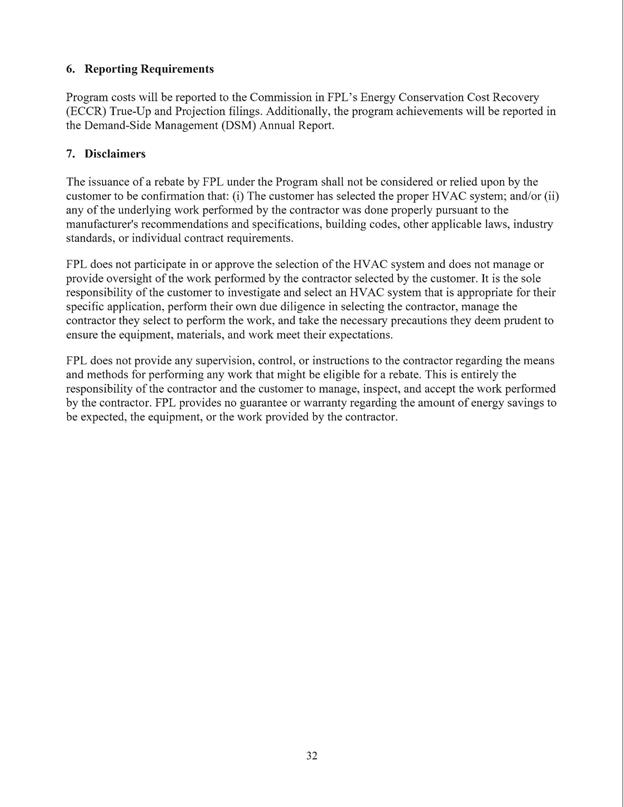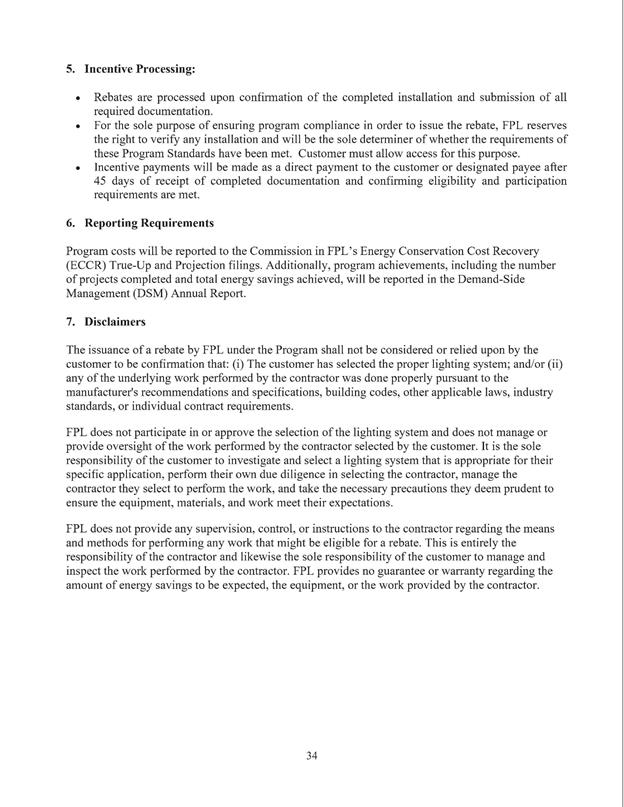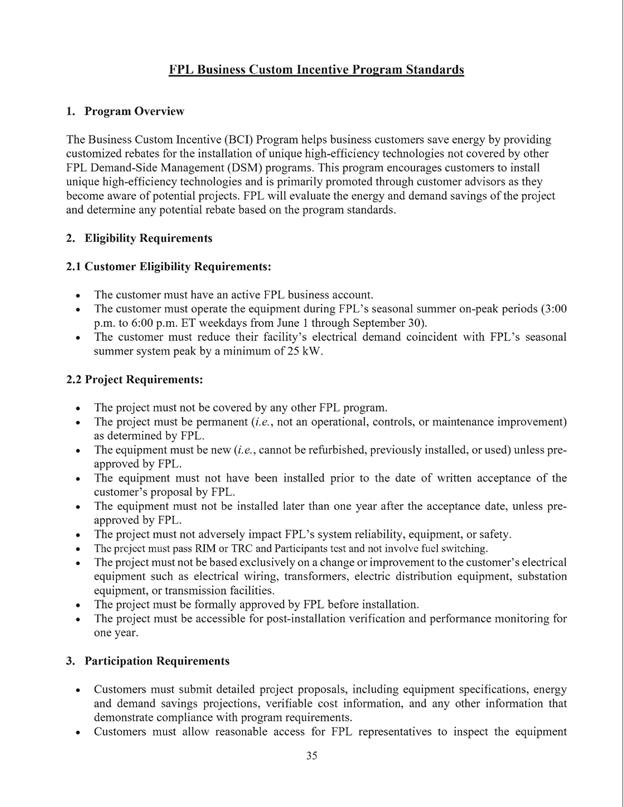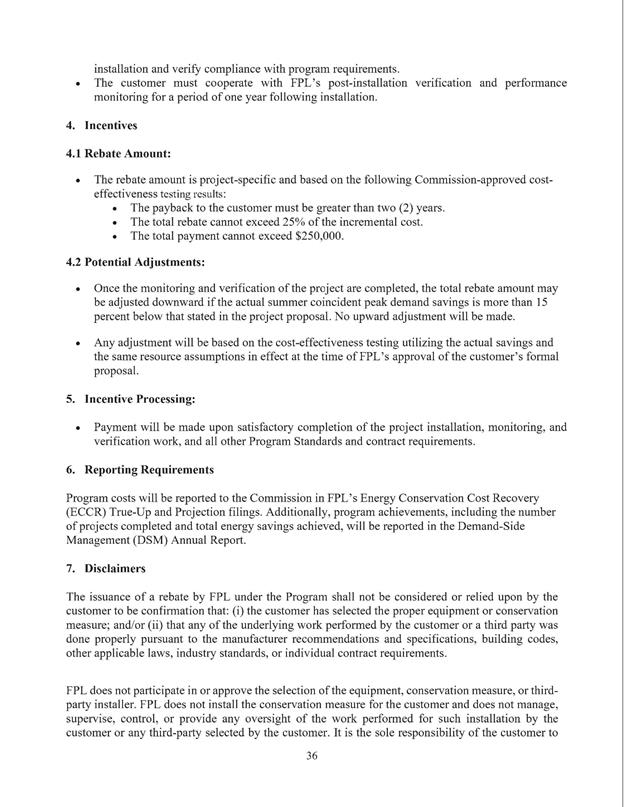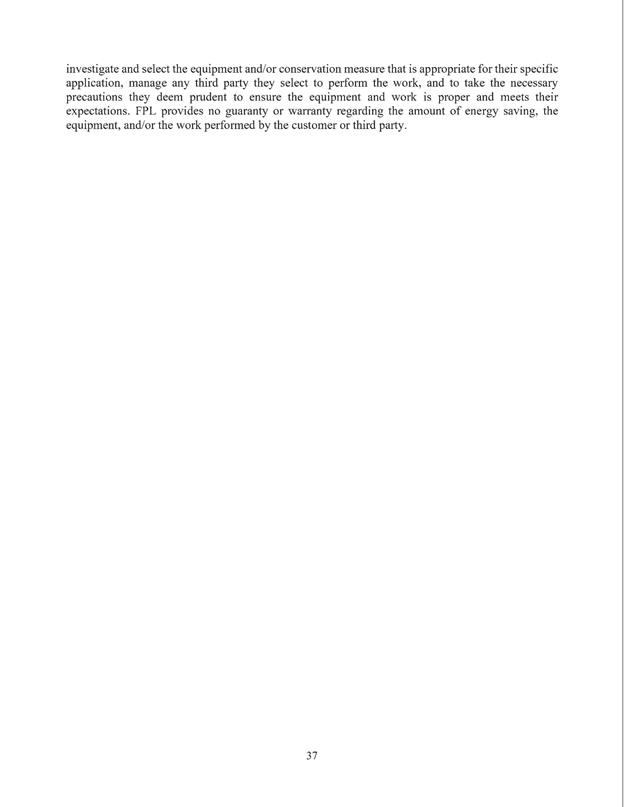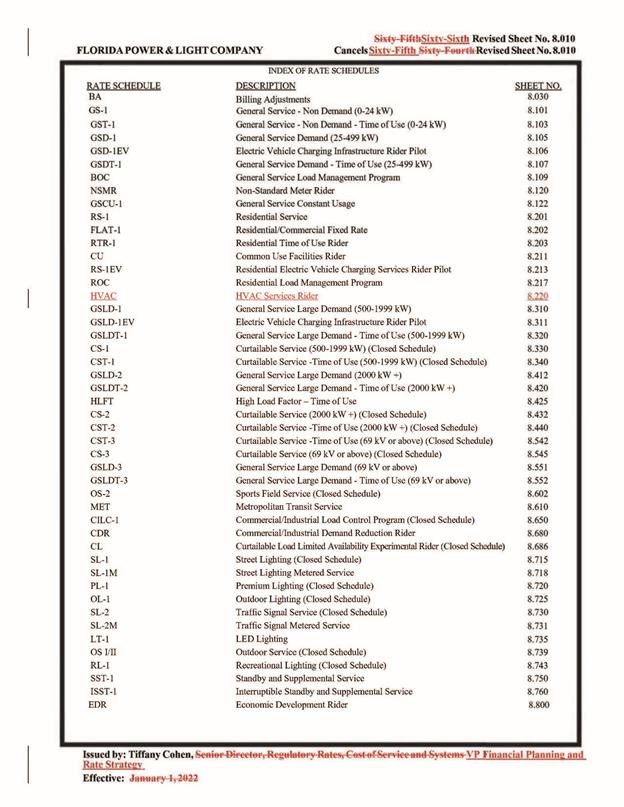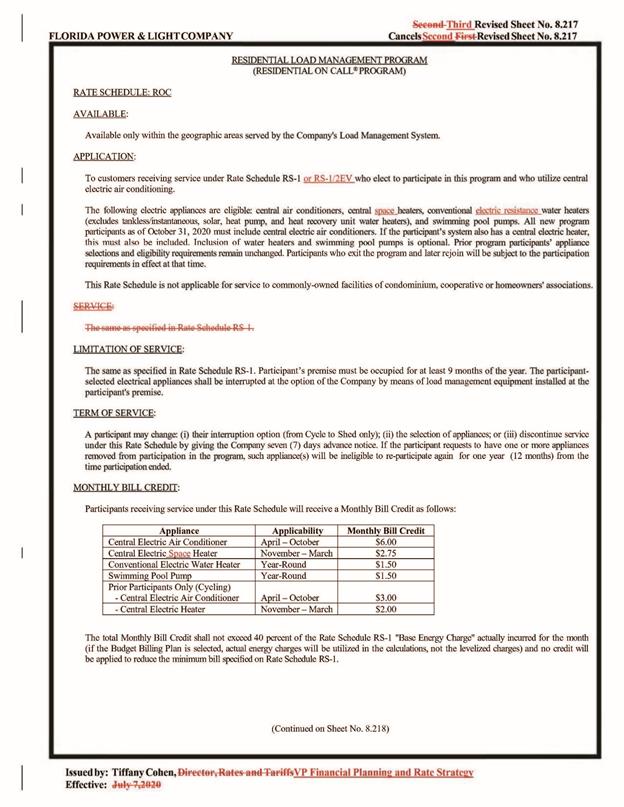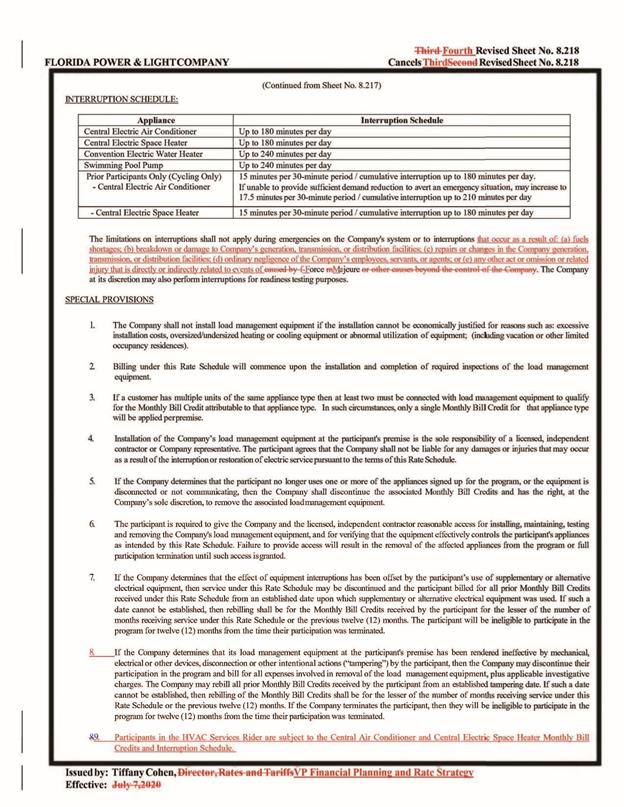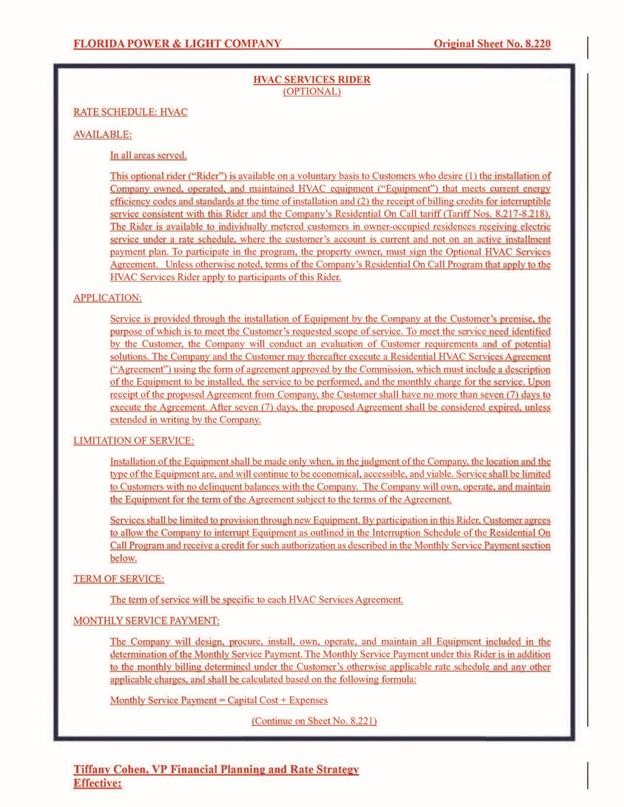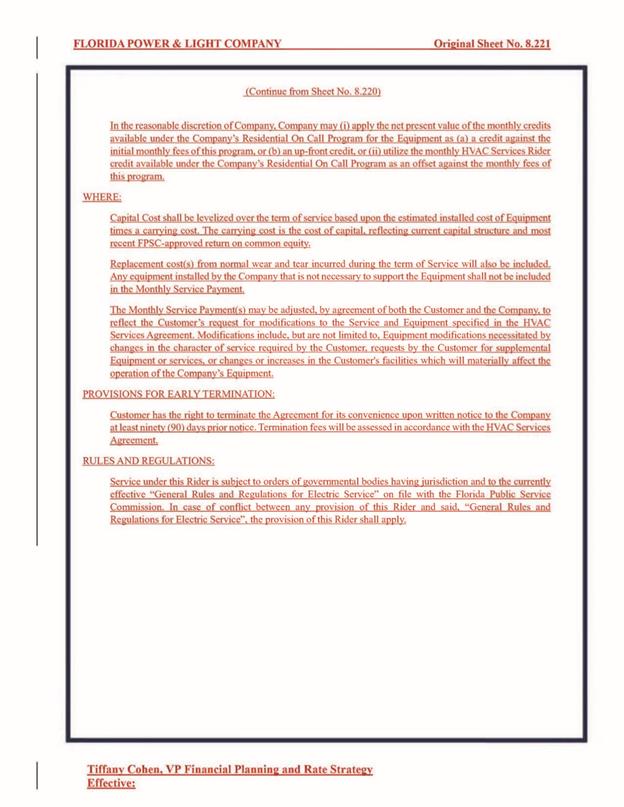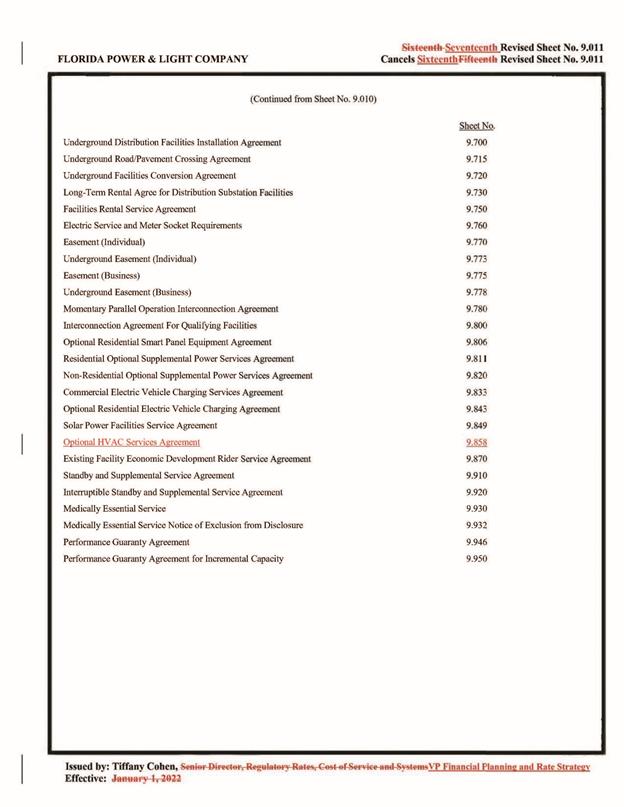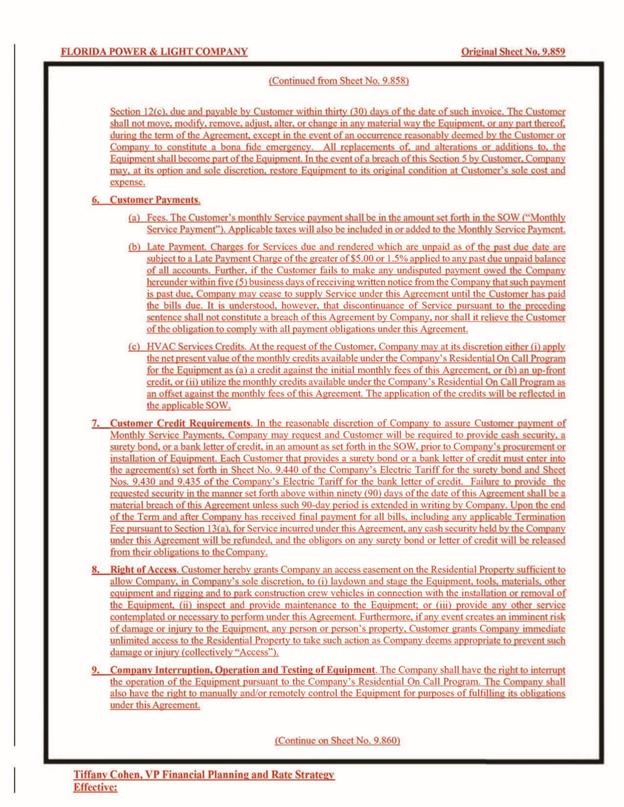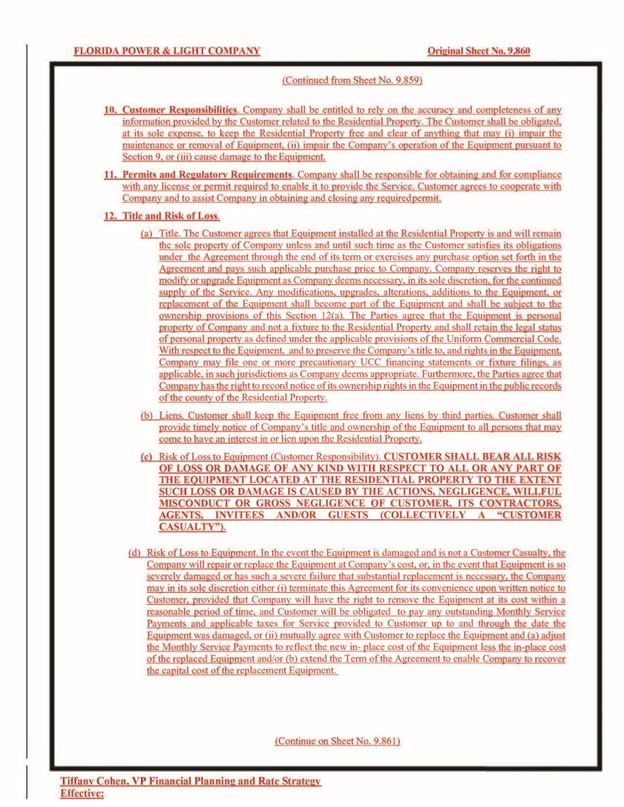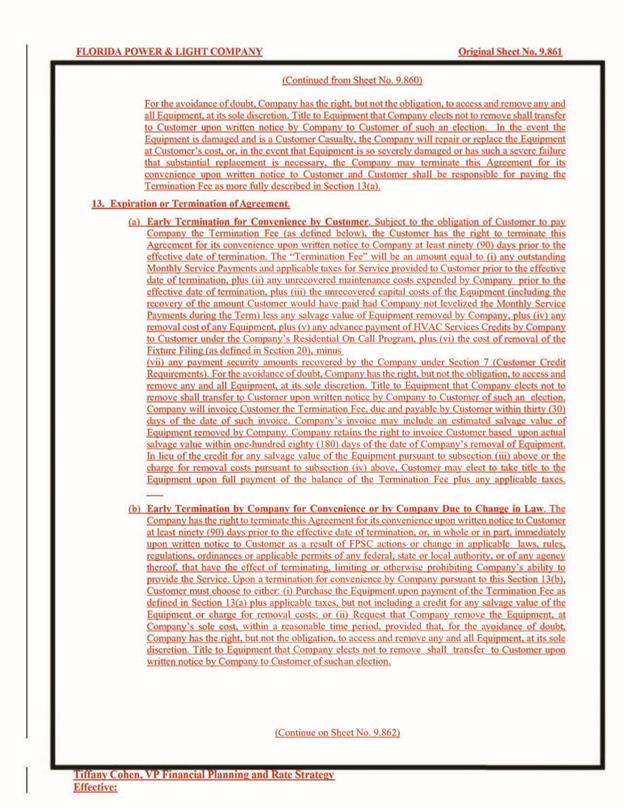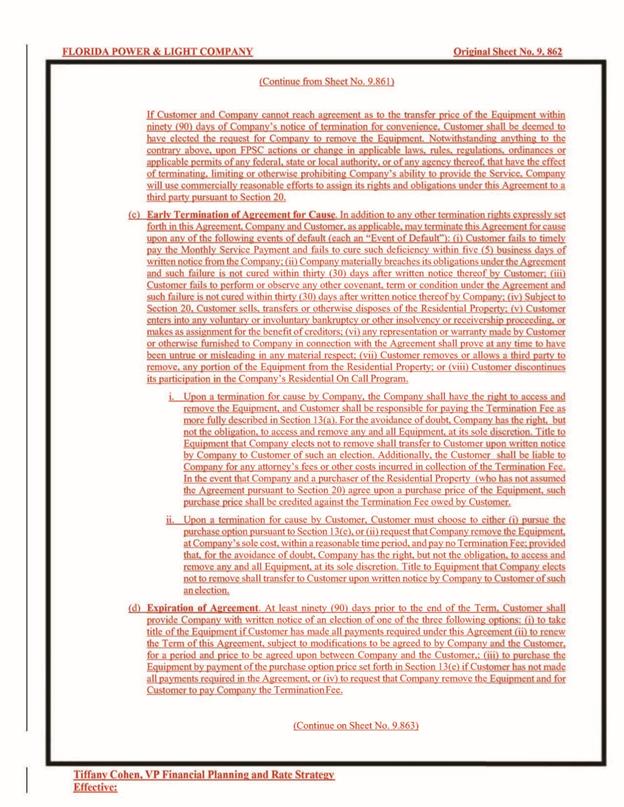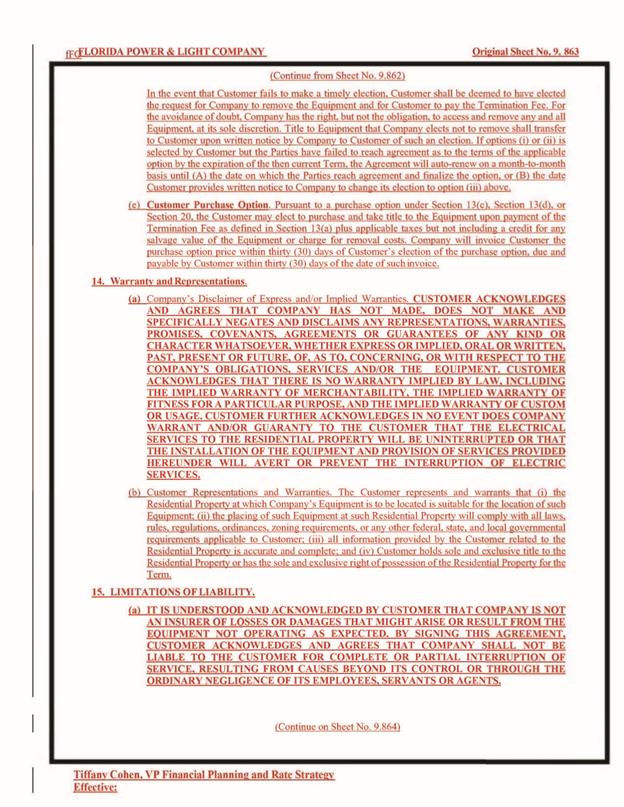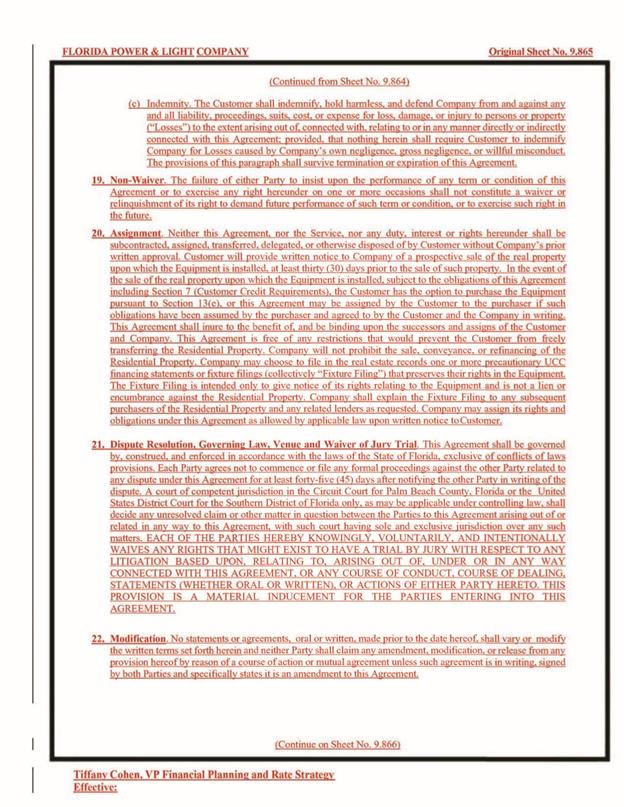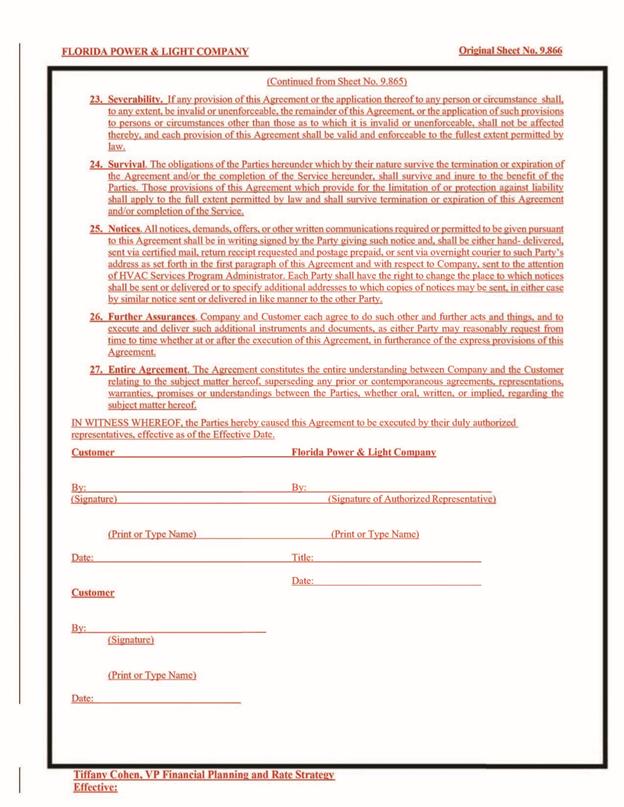Discussion
of Issues
Issue 1:
Should the Commission approve Florida Power &
Light Companyís proposed DSM Plan, program standards, and tariffs?
Recommendation:
Yes, with modifications. The programs included in FPLís
proposed DSM Plan are cost-effective based upon the Participants test, and
either the Rate Impact Measure (RIM) or Total Resource Cost (TRC) test. FPLís
DSM Plan is projected to meet the annual numeric conservation goals approved by
the Commission in the 2024 Goalsetting Order. In addition, staff has reviewed FPLís
program participation standards and they appear to be consistent with FPLís DSM
Plan.
However, staff recommends the following modifications to
FPLís HVAC On-Bill Pilot program: (1) require participants to also participate
in FPLís Residential HVAC program; (2) eliminate the participantsí requirement
to participate in the Residential On Call program for the entire 10-, 12-, or
15-year service agreement terms; (3) cap program participation at the
projections provided by FPL; and (4) cap program costs to those costs agreed
upon by FPL and program participants at the time the service agreements are
executed. These modifications would more closely align with the objectives of
FEECA by increasing overall energy efficiency savings, remove participantsí
long-term commitment for participation in a load management program, and provide
additional safeguards for the general body of ratepayers during the pilot phase
of the program.
If staffís proposed modifications are approved, staff
recommends that FPL submit revised versions of its Optional HVAC Services Rider
tariff, Optional HVAC Services Agreement tariff, and program participation
standards, as applicable, that reflect these modifications within 30 days of
the Consummating Order in this docket, and that the Commission grant staff
administrative authority to review and approve these documents. If the
Commission approves FPLís proposal without modifications, then the tariffs as
shown in Attachment C should be approved effective on the day of the
Commissionís vote.
Upon final approval by the Commission, FPL may file for
cost recovery of the programs included in its DSM Plan in the Energy
Conservation Cost Recovery (ECCR) clause proceeding. However, FPL must
demonstrate that the expenditures to implement its DSM programs are reasonable
and prudent in order to recover those expenditures. (Thompson, Hampson)
Staff Analysis:
Section
366.82(7), F.S., requires that following the adoption of annual conservation
goals, the Commission shall also require each utility subject to FEECA to
develop a DSM plan to meet its conservation goals. Rule 25-17.0021(4), Florida
Administrative Code (F.A.C.), requires each electric utility subject to FEECA
to file its DSM plan, which consists of one or more DSM programs, and program
participation standards for Commission approval.
The
Commission considers the appropriateness of DSM programs by evaluating the
following criteria, first outlined in Order No. 22176: (1) whether the program
advances the policy objectives of FEECA and its implementing rules (such as
reducing demand and energy usage); (2) whether the program is directly
monitorable and yields measurable results; and (3) whether the program is
cost-effective. Pursuant
to 366.82(7), F.S., the Commission may then elect to approve, modify, or deny
the utilityís DSM plan.
FPLís Proposed DSM Plan
As a result
of the 2023 amendments to Rule 25-17.0021, F.A.C., the utilities subject to
FEECA proposed, and the Commission established, DSM goals based upon proposed
DSM programs for the first time. Staff reviewed FPLís proposed DSM Plan,
including its demand and energy savings, cost-effectiveness, and rate impact.
Overall, the programs within the proposed DSM Plan are consistent with the
proposed DSM programs evaluated by the Commission in the 2024 Goalsetting
proceeding. A complete list of the programs and a brief description of each can
be found in Attachment A. Staff has also reviewed FPLís program participation
standards, which can be found in Attachment B, and they appear to be consistent
with FPLís DSM Plan.
FPLís proposed
DSM Plan consists of a total of 15 programs, including seven residential
programs, two of which are pilot programs, seven commercial/industrial
programs, and one research and development program. FPL has proposed to
continue 13 existing programs, three with modifications, and add two new
programs. The modifications consist of removing measures that were no longer
cost-effective, and adding new measures that were cost-effective based on the
2024 Technical Potential Study, and suitable for inclusion in FPLís current
programs. FPLís new programs, the Low-Income Renter Pilot program and
the HVAC On-Bill Pilot program, were included in the proposed programs used to
develop FPLís DSM goals in its 2024 goalsetting proceeding. The Utility stated
that the Low-Income Renter Pilot program was added to incentivize landlords of
low-income rental properties to install higher efficiency heating, ventilation,
and air conditioning (HVAC) equipment to benefit current and future tenants
with lower energy bills. Participation in the pilot is limited to 500
installations per year over a three-year pilot period to assess the program's
effectiveness. The HVAC On-Bill Pilot program is discussed below.
As noted
above, the 15 programs included in FPLís DSM Plan are consistent with the
proposed programs used to develop FPLís DSM goals in its 2024 goalsetting
proceeding, with the exception of FPLís HVAC On-Bill Pilot program, which is
discussed below, and the Conservation Research and Development (CRD) program. The
CRD program does not directly produce demand or energy savings, but it has been
included in FPLís prior DSM Plans and allows the Utility to investigate
technologies that may support the development of new demand response and energy
efficiency programs. These studies have resulted in several measures being
incorporated into FPLís DSM portfolio, and also serve as a source for providing
FPLís customers with accurate information and responses to their energy
technology questions. As such, staff believes that the
continued inclusion of the CRD program in FPLís DSM Plan is reasonable.
Regarding
program participation rates, FPLís projected program participation rates for
the programs included in its DSM Plan are consistent with the participation
rates provided in the Stipulation that was approved per the 2024 Goalsetting
Order, including the participation increase for FPLís Residential Low-Income
Weatherization program. The projected program demand and energy savings
meet the goals established by the Commission in the 2024 Goalsetting Order, and
the programs included in FPLís DSM Plan are directly monitorable and
measurable.
As
required by Rule 25-17.008, F.A.C., FPL provided cost-effectiveness
analyses for the programs included in its DSM Plan using the Participants, RIM,
and TRC tests. The programs included in FPLís proposed DSM Plan are
cost-effective based upon the Participants test, and either the RIM or TRC
test. Table 1-1 shows an estimate of the annual ECCR expenditures and monthly
rate impact on a typical residential customer for FPLís DSM Plan.
Table 1-1
FPLís DSM Plan Annual ECCR Costs and Estimated Monthly
Rate Impact
|
Year
|
Annual ECCR
Costs
|
Residential
Customer
|
|
($)
|
($/1,000
kWh/mo)
|
|
2025
|
$170,699,814
|
$1.44
|
|
2026
|
$170,490,353
|
$1.43
|
|
2027
|
$166,239,808
|
$1.38
|
|
2028
|
$165,738,981
|
$1.36
|
|
2029
|
$166,047,747
|
$1.35
|
|
2030
|
$166,869,100
|
$1.33
|
|
2031
|
$167,001,598
|
$1.31
|
|
2032
|
$166,874,551
|
$1.29
|
|
2033
|
$167,058,768
|
$1.26
|
|
2034
|
$167,278,257
|
$1.24
|
|
Total
|
$1,674,298,976
|
-
|
Source: Document No. 03028-2025
The results
of these cost-effectiveness analyses are consistent with the cost-effectiveness
analyses results provided for the proposed programs used to develop FPLís DSM
goals in its 2024 goalsetting proceeding. Therefore, staff recommends that
FPLís DSM Plan, with the modifications discussed below, and the associated
program participation standards be approved.
FPL
is responsible for monitoring actual participation rates and seeking Commission
action, if necessary, to modify, add, or remove programs. If FPL is unable to
meet the DSM goals established by the Commission, the Utility may be subject to
appropriate action by the Commission.
HVAC On-Bill Pilot Program
The proposed HVAC On-Bill Pilot program is an option
within FPLís traditional Residential On Call program that would
allow participants to acquire a new HVAC unit under the Utilityís proposed HVAC
Services Rider and Optional HVAC Services Agreement. To qualify, participants
would need to meet FPLís proposed eligibility requirements, which include being
home owners, being in good standing with the Utility, and meeting the Utilityís
minimum credit requirements (i.e., providing a cash security, a surety bond, or
a bank letter of credit as requested by the Utility). In addition, participants
are required to install an HVAC that meets the minimum baseline efficiency
standard, but may opt to install a more energy-efficient HVAC unit, if desired.
FPL, through its authorized contractors, will design, procure, and install the
HVAC units, and offer participants the option of a 10-, 12-, or 15-year term,
dependent on the life of the HVAC equipmentís warranty. Under the HVAC On-Bill
Pilot program, FPL would own and maintain the HVAC unit for the duration of the
term, and participants would be required to make levelized monthly payments,
which would cover the capital cost of the HVAC equipment, including a return on
capital investment, plus all operations and maintenance expenses for the unit,
including administrative costs and assumptions for uncollectible customer
payments (bad debt), for the duration of the agreement. Upon participant selection
and at FPLís discretion, the HVAC On-Bill Pilot program load management credits
would be applied as one of the following options: (1) the net present value of
the monthly credits available under the traditional Residential On Call program
as (a) a credit against the participantís initial monthly fees, or (b) an
up-front credit; or (2) as an offset against the monthly program fees as
provided under the traditional Residential On Call program. Once all payment
obligations under the service agreement are satisfied, the participant can take
ownership of the HVAC unit.
The costs associated with the HVAC On-Bill Pilot program
would flow through the ECCR clause. Due to the levelized program design, the
general body of ratepayers would subsidize the program during the first half of
each service agreement term, but are projected to be made whole under the
second half of the agreement terms as participantsí levelized monthly payments
exceed the declining revenue requirements. In the event of any under-recoveries
related to program costs, such as maintenance, repair, or administrative costs
above the estimates included in the monthly payment obligations under the
service agreements, and/or payment defaults, FPL intends to recover these costs
from future participantsí payments. This includes any costs associated with
debt collection attempts, bad debt, and return on capital investment. These
costs would also be subsidized by the general body of ratepayers initially
through the ECCR clause before being fully recovered from future HVAC On-Bill
Pilot program participants. In the event of payment defaults, FPL has indicated
that participants would be subject to disconnection of their electric service,
as a last resort, after providing at least five working days written notice if
the payment default is not cured. However, FPL indicated that should there
remain any under-recovered costs from program participants, the balance would be
recovered from the general body of ratepayers through the ECCR clause.
FPLís HVAC On-Bill Pilot program was originally proposed
as a permanent program in the 2024 goalsetting proceeding, but has since been
reclassified as a five-year pilot program, and includes updated costs, as a
result of discussions with staff, to align HVAC On-Bill credits with the
credits provided under FPLís traditional Residential On Call program. FPL
has also made additional modifications based on these discussions, which
include modifying the participantsí property insurance requirements, and
providing each participant an informational document summarizing the terms and
conditions under the Optional HVAC Services Agreement. Regarding the property
insurance, FPL will now secure insurance to cover any force majeure loss or
damages to the HVAC equipment, and will recover these costs from participants
over the life of the service agreement. Regarding the informational document,
FPL will ensure that customers enrolling in the HVAC On-Bill Pilot program have
full awareness of the terms and conditions, including the required payment
schedule for the service, costs for early termination of the service agreement,
and the possibility of electric service disconnection as a result of payment
defaults. FPL also indicated that the monthly charge for the program would be
shown as a separate line item on the participantís electric bill. Regarding
reporting, FPL indicated that during the term of the HVAC On-Bill pilot period,
the Utility will report pilot costs and revenues to the Commission in the
Utilityís annual ECCR True-Up and Projection filings, and report pilot
achievements in the Utilityís DSM Annual Report.
Staff believes that the modifications described above will
improve the program, but recommends the following additional HVAC On-Bill Pilot
program modifications to further due so: (1) require participants to also
participate in FPLís Residential HVAC program; (2) eliminate the participantsí
requirement to participate in the Residential On Call program for the entire
10-, 12-, or 15-year service agreement terms; (3) cap program participation at
the projections provided by FPL; and (4) cap program costs to those costs
agreed upon by FPL and program participants at the time the service agreements
are executed. Each of these modifications are discussed further below.
The first proposed modification would result in the installation
of an HVAC unit above the minimum SEER standard, and allow participants to also
receive a rebate for the installation of a high efficiency HVAC unit, which could
assist with participantsí overall HVAC On-Bill Pilot program costs. This
modification would also increase participantsí overall energy efficiency
savings, which further aligns with the FEECA initiatives and the stipulation
language agreed upon by FPL and the parties in the Commission-approved 2024
Goalsetting Order. Based on
example cost estimates provided by FPL, a participant would pay approximately $20,035
over a 10-year service agreement term for expenses associated with the
installation of a 16 SEER HVAC unit under the service agreement, as compared to
$18,730 for a similarly sized 15 SEER HVAC unit, which is the minimum SEER
rating for Florida, over the same service agreement term.
This amount would be further reduced to approximately $19,835 for a 16 SEER
HVAC unit over the same service agreement term due to participation in FPLís
Residential HVAC program. This results in a cost differential of approximately $1,105
over the 10-year service agreement term, which staff believes is reasonable
based on the additional energy efficiency savings a participant would receive
as a result of installing a more efficient HVAC unit. As such, staff recommends
that this modification be approved.
The second proposed modification to eliminate the
participantsí requirement to participate in the Residential On Call program for
the entire 10-, 12-, or 15-year service agreement terms provide participants
flexibility if they decide that they no longer want their loads controlled. As
currently proposed, HVAC On-Bill Pilot program participants would be required
to pay an early termination fee, which consists of the remaining payment
obligations under their service agreements and a refund of any advanced payment
of bill credits, in order to exit the program. This means that participants who
are not satisfied with the load control program will not be able to discontinue
having their loads controlled, and therefore will have to continue doing so
throughout the duration of their 10-, 12-, or 15-year service agreement terms,
or pay the termination fee. However, under the traditional Residential On Call
program, participants are able to exit the program at any time and at no cost,
as long as FPL is provided at least seven days advance notice. As such, staff
recommends that the same flexibility provided to participants of the
traditional Residential On Call program be provided to HVAC On-Bill Pilot
program participants. However, those participants who received advanced payment
of bill credits but elect to leave the load control portion of the HVAC On-Bill
Pilot program should be required to pay the termination fee associated with
only those credits to exit the program. In addition, participants exiting the
program would still be responsible for the remaining monthly payments
associated with the HVAC equipment and maintenance. By keeping the existing
Residential On Call and the HVAC On Bill Pilot programs aligned, the Utility
and the Commission can gain valuable information regarding the impact of the
HVAC On-Bill Pilot program. Basically, such modifications would focus the
results to the impact of providing a novel financing option to customers.
The third and fourth proposed modifications to cap program
participation at the projections provided by FPL, and cap program costs to
those costs agreed upon by FPL and program participants at the time the
Optional HVAC Services Agreements are executed, would provide additional
protection for the general body of ratepayers. As proposed and as previously
discussed, the costs associated with the executed service agreements would flow
through the ECCR clause, and due to the HVAC On-Bill Pilot program design, the
general body of ratepayers would already be responsible for the shortfalls
during the first half of each service agreement term as participantsí payments
would be levelized over the agreement terms. If allowed as proposed, the
general body of ratepayers would also be at risk if there are any
under-recovered costs that are not able to be recovered from program
participants, as indicated by FPL. Traditionally, it has been Commission
practice that pilot programs serve as vehicles for utilities to explore new
technologies or processes, and assess the benefits using a sample prior to
permanent implementation. As
such, staff believes that capping program costs and participation would allow
FPL to evaluate the potential program cost differentials and benefits prior to
full scale implementation while providing additional protection for the general
body of ratepayers. This information may then enable the Utility to more
accurately determine participant program costs in order to develop a future
program or tariff offering. As such, staff believes that limiting the allowance
of costs that flow through the ECCR clause to those costs agreed upon by FPL
and the participants at the time that the service agreements are executed, and
capping program participation to the projections provided by FPL, would limit
the risk to the general body of ratepayers, and therefore recommends that this
modification be approved. FPL would still have the ability to either work
directly with the program participants separately to recover any additional
costs, or modify the pilot program as necessary without adding additional risk
to the general body of ratepayers.
If staffís proposed modifications are approved, staff
recommends that FPL submit revised versions of its Optional HVAC Services Rider
tariff, Optional HVAC Services Agreement tariff, and program participation
standards that reflect these modifications, and grant staff authority to
administratively approve them, if consistent with the modifications above. The documents
should indicate participantsí option to opt out of the load management portion
of the HVAC On-Bill Pilot program, outline participantsí requirements to be
eligible to do so, and provide an annual estimate of the amount to be refunded
for any advanced payment of bill credits. If the Commission approves FPLís
proposal without modifications, then the tariffs as shown in Attachment C
should be approved effective on the day of the Commissionís vote.
Conclusion
The programs included in FPLís proposed DSM Plan are
cost-effective based upon the Participants test, and either the RIM or TRC test.
FPLís DSM Plan is projected to meet the annual numeric conservation goals
approved by the Commission in the 2024 Goalsetting Order. In addition, staff
has reviewed FPLís program participation standards and they appear to be
consistent with FPLís DSM Plan.
However, staff recommends the following modifications to
FPLís HVAC On-Bill Pilot program: (1) require participants to also participate
in FPLís Residential HVAC program; (2) eliminate the participantsí requirement
to participate in the Residential On Call program for the entire 10-, 12-, or
15-year service agreement terms; (3) cap program participation at the
projections provided by FPL; and (4) cap program costs to those costs agreed
upon by FPL and program participants at the time the service agreements are
executed. These modifications would more closely align with the objectives of
FEECA by increasing overall energy efficiency savings, remove participantsí
long-term commitment for participation in a load management program, and
provide additional safeguards for the general body of ratepayers during the
pilot phase of the program.
If staffís proposed modifications are approved, staff
recommends that FPL submits revised versions of its Optional HVAC Services
Rider tariff, Optional HVAC Services Agreement tariff, and program
participation standards, as applicable, that reflect these modifications within
30 days of the Consummating Order in this docket, and that the Commission grant
staff administrative authority to review and approve these documents. If the
Commission approves FPLís proposal without modifications, then the tariffs as
shown in Attachment C should be approved effective on the day of the Commissionís
vote.
Upon final approval by the Commission, FPL may file for
cost recovery of the programs included in its DSM Plan in the ECCR clause
proceeding. However, FPL must demonstrate that the expenditures to implement
its DSM programs are reasonable and prudent in order to recover those
expenditures.
Issue 2:
Should this docket be closed?
Recommendation:
Yes. If no person whose substantial interests are
affected by the proposed agency action files a protest within 21 days of the
issuance of the order, a consummating order will be issued. However, if Issue 1
is approved, the docket should remain open for staffís verification that the
revised documents have been filed by the Utility and approved by staff. When
the proposed agency action is final and the revised documents have been
approved, this docket may be closed administratively. (Imig, Sparks)
Staff Analysis:
If no person whose substantial interests are
affected by the proposed agency action files a protest within 21 days of the
issuance of the order, a consummating order will be issued. However, if Issue 1
is approved, the docket should remain open for staffís verification that the
revised documents have been filed by the Utility and approved by staff. When
the proposed agency action is final and the revised documents have been
approved, this docket may be closed administratively.
Florida Power & Light Company 2025 Ė 2034 DSM Programs
Residential Programs:
Residential
Energy Survey Program
The Residential Energy Survey
program is designed to educate customers on energy efficiency and encourage
them to participate in FPLís demand-side management (DSM) programs, as well as
implement recommended energy-saving measures and practices that may not be
included in FPLís residential programs. In addition to individual surveys, the
program offers customer education on conservation measures through
presentations at community events and local schools. The Residential Energy
Survey program plays a crucial role in helping educate FPL customers on ways to
reduce energy consumption and costs while supporting FPL's overall DSM efforts.
The program assists customers in recognizing potential energy savings and helps
identify candidates for other FPL DSM programs. By offering various channels
for energy surveys and promoting energy efficiency education, the program
ensures that all FPL residential customers, whether homeowners or renters, can
benefit from improved energy efficiency and cost savings. Energy surveys are
offered through the following channels:
∑
Home
Energy Survey: Conducted by an FPL representative at the customerís home, this
in-person survey identifies opportunities for customers to improve energy efficiency
and participate in other FPL DSM programs.
∑
Online
Home Energy Survey: Customers can perform this self-service survey using FPLís
online system, which provides personalized recommendations based on customer
input.
∑
Phone
Energy Survey: Conducted by an FPL representative over the phone using FPLís
online system, this survey provides similar benefits to the in-home survey but
with added convenience.
Residential
Load Management (On Callģ) Program
The Residential On Callģ program is
designed to help FPL manage energy demand by allowing the utility to turn off
certain customer-selected appliances during periods of extreme demand, capacity
shortages, and system emergencies including system frequency regulation. FPL
installs equipment to control eligible appliances, including central air
conditioners/electric heating, water heaters, and pool pumps. Through this
program, customers are educated on the benefits of participating in load
management initiatives which help maintain system reliability and efficiency.
By enrolling in the Residential On Callģ program, customers actively contribute
to reducing peak demand and overall energy consumption during critical periods,
supporting both personal cost savings and broader energy conservation goals.
HVAC
On-Bill (HOB) Pilot Program
The HOB pilot is an option within
FPLís Residential On Callģ program that provides customers with new HVAC equipment,
routine service, and maintenance for a fixed monthly charge on their electric
service bill. The HOB pilot encourages the adoption of efficient, new HVAC
equipment without requiring an upfront payment from the customer and provides
cost-effective load control to FPL and the general body of customers. The HVAC
equipment installed under the pilot is subject to load management and
participants receive bill credits in accordance with the Utilityís Residential
On Callģ tariff and the HVAC Services Agreement.
Residential
HVAC Program
The Residential HVAC program aims to
help customers reduce their heating and cooling costs by providing rebates for
the installation of high-efficiency central air conditioning or heat pump
systems. This program educates customers on the benefits of installing high-efficiency
HVAC systems to reduce energy costs and improve overall home comfort. By providing
a monetary incentive, the program encourages customers to opt for systems that exceed
federal efficiency standards, thereby contributing to energy conservation and
DSM goals. The goal is to encourage the adoption of high-efficiency HVAC
systems, thereby enhancing energy efficiency in residential settings. FPL
delivers this program through Participating Independent Contractors (PICs), who
offer the rebate to the customer at the time of qualifying air conditioning or
heat pump installation.
Residential
Ceiling Insulation Program
The Residential Ceiling Insulation
program encourages customers to improve their homeís thermal efficiency by
providing rebates for ceiling insulation in qualifying homes. FPL delivers this
program through PICs, who provide the rebate to the qualifying customer at the
time of ceiling insulation installation. The program aims to enhance energy
efficiency and reduce energy consumption in residential properties by improving
the building envelopeís thermal efficiency.
Residential New
Construction (BuildSmartģ) Program
The Residential BuildSmartģ program is
designed to encourage builders and developers to design and construct
energy-efficient new homes that achieve BuildSmart certification and move to
achieve ENERGY STARģ qualifications, achieving an energy performance
improvement score of at least ten points better than current building codes require.
The program educates builders and developers on the benefits of constructing energy-efficient
homes and provides technical support, regular training, and certification processes,
alongside financial incentives to builders. By promoting superior building practices
that align with ENERGY STARģ qualifications, the program leads to significant energy
savings and enhanced sustainability. The BuildSmartģ program is delivered to builders,
developers, and owner-builders of new homes by FPL Program Specialists who certify
that the homes meet the BuildSmart program requirements.
Residential
Low-Income Weatherization Program
The Residential Low-Income
Weatherization program is specifically designed to assist low-income customers
by providing direct installation of energy saving measures. The program operates
through two distinct models. First, low-income areas are identified and
proactively canvassed to recruit qualifying customers for measure installation
through FPLís Community Energy Saver initiative. The initiative also includes a
free energy survey to help customers identify additional low and no-cost ways
to reduce energy consumption. Second, Weatherization Assistance Providers or
other FPL-approved agencies who have installed specified measures can submit
rebate requests to FPL.
Low-Income Renter
Pilot Program
FPLís Low-Income Renter Pilot program
encourages landlords of low-income rental properties to upgrade HVAC systems
for energy efficiency, benefiting renters with lower energy bills. The program
offers financial incentives to cover the incremental cost of replacing
code-compliant units with high-efficiency HVAC systems. This initiative
supports FPLís commitment to energy conservation and helps low-income renters
reduce their energy costs. Participation is limited to 500 installations per
year over three years to assess the program's effectiveness for potential
future expansion.
Commercial/Industrial Programs:
Business Energy Evaluation (BEE) Program
The BEE program is designed to
educate customers on energy efficiency and encourage the implementation of
recommended practices and measures, even if these are not included in FPLís DSM
programs. The BEE program is also used to identify potential candidates for other
FPL DSM programs. This program is delivered through three channels: online
through an FPL system, by phone with FPL representatives using the online
system, or on-site by FPL representatives. These delivery methods ensure that
business customers, whether they own or rent their facility, can access the
program and benefit from its services.
Business On Callģ
Program
The Business On Callģ program is
designed to help FPL manage energy demand by allowing the utility to turn off
air conditioners during periods of extreme demand, capacity shortages, and
system emergencies including system frequency regulation. FPL installs
equipment to control customerís Direct Expansion (DX) central electric air conditioners.
Through this program, customers are educated on the benefits of participating in
load management initiatives which help maintain system reliability and
efficiency. By enrolling in the Business On Callģ program, customers actively
contribute to reducing peak demand and overall energy consumption during
critical periods, supporting both personal cost savings and broader energy
conservation goals. The Business On Callģ program utilizes contractors to
install and service the load control equipment necessary for participation.
Commercial/Industrial Demand Reduction
(CDR) Program
The CDR program is designed to allow
FPL to control customer loads of 200 kW or greater during periods of extreme
demand, capacity shortages, or system emergencies. Participating customers
receive monthly bill credits based on the amount of kW they are willing to have
interrupted. Participation in the program is governed by the FPL CDR Rider and
Agreement. Each customer enrollment is unique, determined by the specific
amount of kW the customer agrees to have interrupted. Once a completed
agreement is executed, contractors install equipment at the customerís premises
that allow FPL to remotely interrupt the applicable load.
Commercial/Industrial
Load Control (CILC) Program (CLOSED)
The CILC program allows FPL to control
customer loads of 200 kW or greater during periods of extreme demand, capacity
shortages, or system emergencies. This initiative helps maintain system
reliability and efficiency by shedding large commercial and industrial customer
loads as referenced in the CILC agreement. The program is governed by the
requirements in FPL CILC Tariff Sheet Nos. 8.650 Ė 8.659 and applicable
Agreement. The program was closed to new participants as of December 31, 2000, and
is only available to existing participants who had entered into a CILC
agreement as of March 19, 1996.
Business HVAC Program
The Business HVAC Program is designed
to encourage commercial and industrial customers to install high-efficiency
electric HVAC systems and aims to help these customers reduce their overall heating
and cooling costs. The primary types of eligible systems include chillers and
split/packaged DX systems. The program also encourages the installation of
Variable Frequency Drives on HVAC pumps to enhance system efficiency.
FPL Business
Lighting Program
The Business Lighting Program
encourages customers to install high-efficiency LED lighting systems by
providing incentives for the installation of qualifying lighting fixtures.
Customers enroll in the program by submitting project details, including the
number and size of qualifying lighting fixtures installed, and FPL provides the
rebate through a direct payment to the customer.
FPL Business
Custom Incentive (BCI) Program
The BCI Program helps business
customers save energy by providing customized rebates for the installation of
unique high-efficiency technologies not covered by other FPL DSM programs. FPL
will evaluate the energy and demand savings of the project and determine any
potential rebate based on the program standards.
Other Programs:
Conservation Research and
Development (CRD) Program
The CRD Program identifies and
scientifically evaluates the energy and demand reductions and customer
economics of emerging energy efficiency and demand response technologies and
practices under FPLís climate conditions. This program allows for FPL-specific
analysis to provide accurate assessments of cost-effectiveness and
applicability for possible inclusion in a future DSM Plan.
































